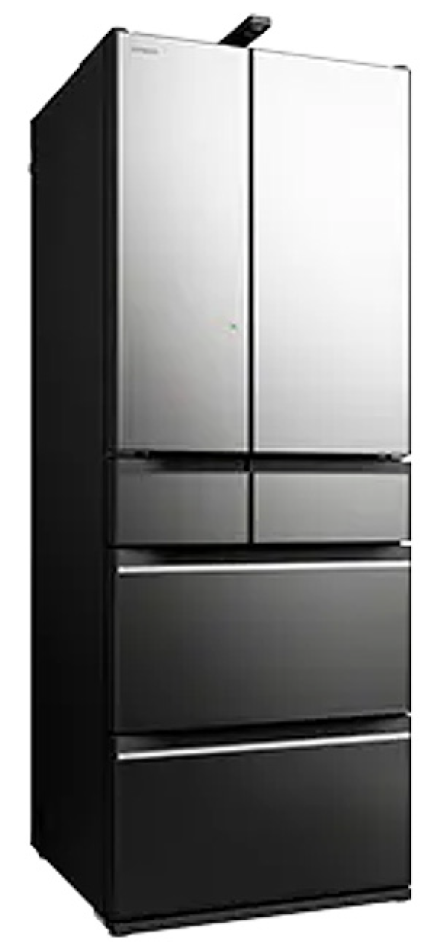Products for the Circular Economy (1)Development of Recycling Equipment for Circular Manufacturing
Highlight
Environmental problems have worsened over recent years, including resource shortages, tightness in energy supply and demand, environmental damage caused by increased waste disposal, and global warming. This has led to calls for a transition away from the linear economy of high-volume production, consumption, and disposal and toward a circular model to help realize a sustainable society. This series of articles focuses on products for such a circular economy, describing new initiatives from the Hitachi Group and where it plans to take these in the future.
This, the first article of the series, presents an example of horizontal recycling in which glass from used refrigerators is efficiently separated and then cleaned by scrubbing and other processes.
1. Introduction
Achieving a sustainable society calls for a transition away from the linear economy of high-volume production, consumption, and disposal and toward a circular economy1).
Appliance recycling in Japan first got underway in a four-year, 5-billion-yen project to develop comprehensive recycling systems for used home appliances that was run from FY1995 to FY1998 by the Association for Electric Home Appliances and funded by what was then the Ministry of International Trade and Industry. The goal of the project was to develop systems for recovering materials from used appliances and efficiently turning them into useful products by safe and labor-efficient means. A pilot plant for appliance recycling was built in the town of Naka in Ibaraki Prefecture in 19962). Able to handle every step from receiving used appliances to dismantling, crushing, sorting, recovery of valuable materials, and detoxification, the plant was used for a wide range of trials. At that time, Hitachi was commissioned by the Association for Electric Home Appliances to act as the lead company in designing the overall process and to develop and test practices for recovering the ozone-depleting fluorocarbons present in refrigerator insulation. The outcomes of this pilot project have since been widely adopted as common practice across Japan, including the establishment of recycling plants throughout the country that use its processes in a variety of different forms.
The types of home appliances covered by the Home Appliance Recycling Law have changed since the time of its introduction as people’s living practices have evolved. A notible example is that cathode-ray televisions have been superceeded by flat screens and this has led to the development of new recyclng practices.
A change that has happened over recent years is that refrigerators are increasingly being sold with exterior door panes made from glass to enhance design appearance and provide scratch resistance (see Figure 1). As a result, increasing numbers of these glass-door refrigerators are now arriving at appliance recycling plants. Unfortunately, because no technique has yet been developed to recover glass from the mix of materials left after a refrigerator is crushed, its presence has a tendency to degrade the quality of other recovered items. Moreover, the difficulty of separating glass from other materials like urethane and plastic means that reusing the glass is difficult and the glass doors are often disposed of as industrial waste. For these reasons, the disposal and processing of glass-door refrigerators in volume has become a problem. Meanwhile, consumer interest in ethical consumption*1 is expected to grow.
Given these circumstances, Hitachi Global Life Solutions, Inc. has partnered with Hitachi, Ltd. since 2017 to develop a system for separating the glass panes from glass-door refrigerators and a system for polishing the separated glass panes to remove any defects, enabling the recycling of the glass as a resource.
- *1
- Consumer behavior that is conscious of people, society, and the environment.
2. Development of Recycling System
2.1 Development of System for Separating Glass from Refrigerator Doors
Figure 2—System for Separating Glass from Refrigerators Doors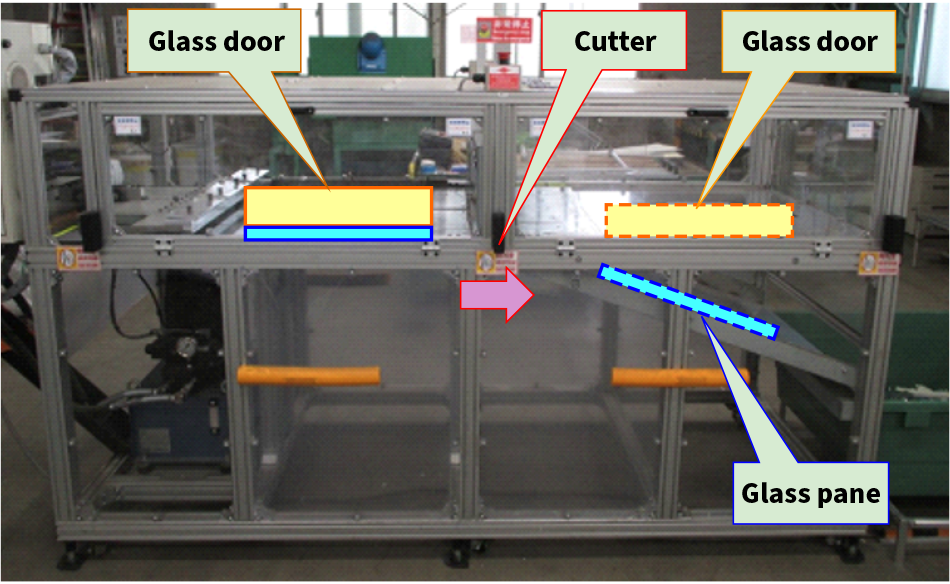 The photograph shows the newly developed system.
The photograph shows the newly developed system.
Figure 3—Diagram of System for Separating Glass from Refrigerator Doors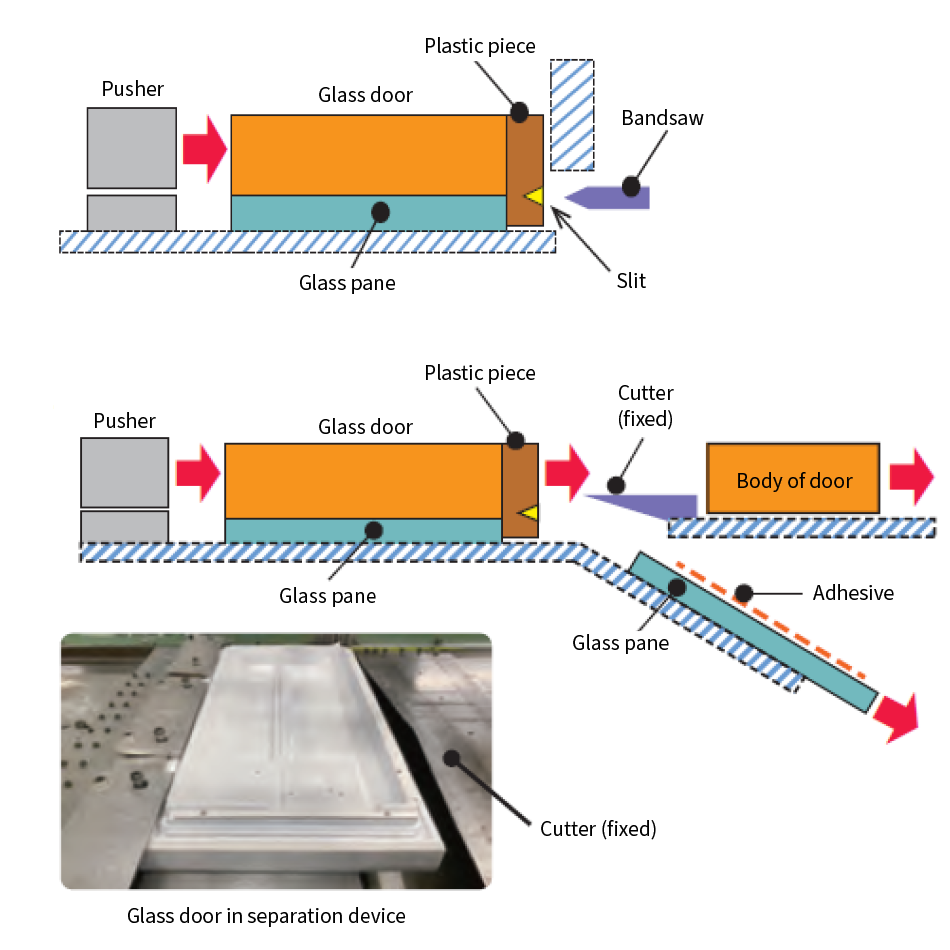 The slitting device makes a cut in the door and the pane separation device inserts a cutter into this slit to separate the glass pane from the door.
The slitting device makes a cut in the door and the pane separation device inserts a cutter into this slit to separate the glass pane from the door.
Rather than recovering the glass intact, the glass from refrigerators has in the past been turned into things like base material for roadbeds.
Anticipating rising numbers of glass-door refrigerators coming in for recycling, Hitachi, Ltd. and Hitachi Global Life Solutions, Inc. also recognized that, if recycling of these appliances was to be encouraged, equipment would be needed that could improve the recycling rate by separating the glass safely and efficiently without breaking it3). Accordingly, they jointly developed a dedicated system for separating glass from refrigerator doors and installed it at Kanto Eco Recycle Co., Ltd., a group company of Hitachi Global Life Solutions4) (see Figure 2).
The system is made up of a slitting device that makes cuts along the side of glass doors and a pane separation device that cuts the glass pane out of the door.
The process of separating the glass involves the following steps (see Figure 3).
- After being detached from the refrigerator, the glass door is inserted into the slitting device.
- A slit is cut in the glass door using a bandsaw while the door is pushed by a pusher (to hold it in place).
- The glass door is removed from the slitting device and inserted into the pane separation device.
- A cutter is inserted into the slit to separate the glass pane while the door is pushed by the pusher.
After the glass pane has been separated, the rest of the door is fed into a crusher along with the refrigerator body. The crushed material is then mechanically sorted for recycling. Meanwhile, the plastic parts, tape, and other material still attached to the glass pane after separation are removed by a glass scrubbing system (described below).
Prior to separating the glass, the system first uses a bandsaw to cut a slit that ensures the cutter can be reliably inserted at the correct position where the glass pane is attached to the door body. A cutter with a V-shaped blade for reliable insertion was chosen and the contact conditions were optimized to enable the glass pane to be separated from the door automatically without breaking it. Another feature of the system is that it works in a way that places little load on the environment, with the cutter peeling the glass pane free of the door by mechanical action, avoiding the need for solvents, ultrasound, heat, or any other special treatment. As separation of the glass pane from the door is performed automatically, a step that has defied automation in the past, the recycling can proceed safely, quickly1), and reliably.
2.2 Development of Glass Scrubbing System
As explained above, the development of the system for separating the glass from refrigerator doors means that the plastic, metal, and other materials from the body of the door can be separated out and recovered. However, the surface of the separated glass pane is still covered in other material such as urethane foam, film, tape, or paint. This poses a new challenge for glass recycling. For the downstream side of the system for separating glass from refrigerator doors, Hitachi Global Life Solutions has developed a dedicated glass scrubbing system for recycling panes of glass that have urethane foam or other material adhering to them. This system, too, was installed at Kanto Eco Recycle4), 5) (see Figure 4).
The system uses a surface scrubbing process in which a number of rotating brushes scrub the glass panes and remove the adhering material. By operating the brushes with an appropriate combination of speeds, the system can clean the urethane foam, paint, and other material from the glass. Moreover, the glass in the refrigerators brought to the recycling plant will have a variety of different widths, with material tending to be more difficult to remove from wider panes. Accordingly, the system was designed to be fitted with progressively larger brush sizes that can clean different widths of glass.
The glass scrubbing process involves the following steps (see Figure 5).
- The glass pane that was separated from the door by the glass separation system is fed into the system where the surface of the glass is first smoothed by using rotating brushes to remove the urethane foam and tape that is stuck to it (the urethane removal step).
- A conveyor then carries the glass to the downstream paint removal step where its surface is scrubbed by a series of brushes. Up to four scrubbing brush stages can be fitted. The upstream brushes remove film and then paint while the final brushes perform polishing.
- The cleaned glass pane is extracted, checked for any remaining paint, and then packed in a box.
Figure 4—Glass Scrubbing System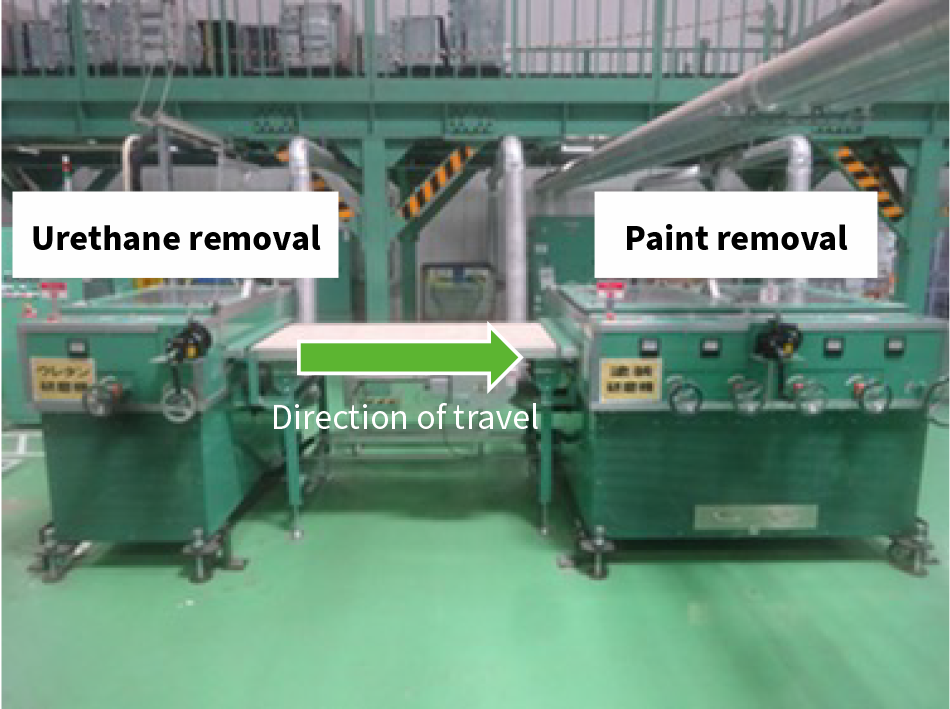 The photograph shows the layout of the new glass scrubbing system.
The photograph shows the layout of the new glass scrubbing system.
Figure 5—Diagram of Glass Scrubbing System The surface of the glass is first smoothed by using scrubbing brushes to remove the urethane foam (the urethane removal step) and then a series of brushes are used to clean off any paint remaining on the glass surface (the paint removal step).
The surface of the glass is first smoothed by using scrubbing brushes to remove the urethane foam (the urethane removal step) and then a series of brushes are used to clean off any paint remaining on the glass surface (the paint removal step).
One of the key issues in developing the system was how to smooth off the surfaces of the glass panes for scrubbing. The recovered glass doors have urethane foam, tape, and film stuck to them in varying different shapes and combinations. These conditions make removing all this adhering material by the same process extremely difficult. Instead, as with the glass door separation system, a two-step process was adopted in which each step targeted a different type of material (see Figure 6). Because it makes it easier to treat different items differently, doing it this way is likely to be helpful when developing recycling techniques that are intended to work on items that do not present in the same condition every time, as is the case with the material stuck to the glass.
A problem that arose during the development of the system was that glass panes with a lot of urethane foam still stuck to them after separation could not be carried on the conveyor, or would cause it to halt before reaching its destination, and that patches of the material would sometime remain depending on the dimensions of the inserted glass pane. This prompted further work on how best to convey and scrub the glass panes to overcome these problems.
First of all, when using a belt conveyor to transport glass panes that still have urethane foam on them, instances were noted of where a loss of grip would cause the scrubbing rollers to free-wheel. Accordingly, a roller conveyor was adopted instead. This increased the gripping force and made it possible to hold glass panes in place even when there is still urethane foam adhering. The shaft diameter of the scrubbing rollers was also increased to reduce torsion by making them more rigid, and the direction and speed of the scrubbing brushes were optimized along with other parameters to reduce instances of the adhering material not being removed.
Through these system development steps, Hitachi succeeded in recovering and recycling the glass doors from refrigerators, including in some cases making them available for horizontal recycling and commercial reuse. However, as some of the recovered glass doors have been coated with materials that are difficult to remove, further system enhancements are underway to improve the system’s versatility.
Figure 6—Progressive Removal of Adhering Material at each Step of Scrubbing Process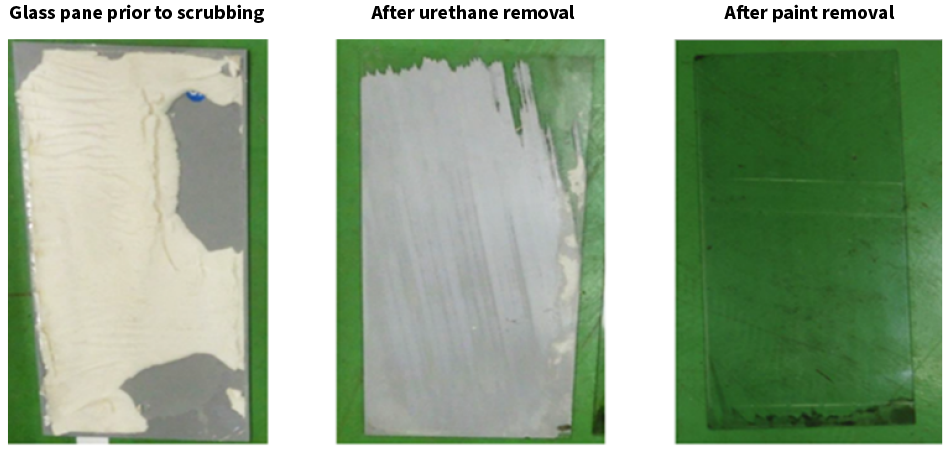 While a large amount of urethane foam is still adhering to the glass before it enters the scrubbing system, the successive steps of the scrubbing process can effectively remove this urethane along with the paint and other adhering material.
While a large amount of urethane foam is still adhering to the glass before it enters the scrubbing system, the successive steps of the scrubbing process can effectively remove this urethane along with the paint and other adhering material.
3. Conclusions
As it seeks to play its part in building a circular economy, Hitachi Group is working to resolve resource problems through practices such as utilizing recycled materials, manufacturing resource-efficient products with a long working life, refurbishment and remanufacturing, and the recycling of used goods. This involves taking action at every step along the value chain, from procurement to design and development, manufacturing, distribution and sales, use, and disposal.
In the future, Hitachi will continue to contribute to the realization of a sustainable society through its work on circular manufacturing practices.
REFERENCES
- 1)
- Hitachi, Ltd., Sustainability Report 2024, Achieving a Resource-Efficient Society
- 2)
- Association for Electric Home Appliances, FY1995 report on project to develop comprehensive recycling systems for used appliances, in Japanese.
- 3)
- T. Nemoto et al., Hitachi’s Current Progress and Future Plans for Recycling Industrial Products, Hitachi Review, 72, 1, pp. 124-129(Mar. 2023)
- 4)
- Hitachi Global Life Solutions, Inc., “Development of System for Automatic Removal of Glass Panes in Recycling of Refrigerators with Glass in their Doors,” (Nov. 2021) in Japanese.
- 5)
- Hitachi Global Life Solutions, Inc., “Development of Glass Scrubbing System for Further Progress toward Circular Manufacturing,” (Jun. 2023) in Japanese.

